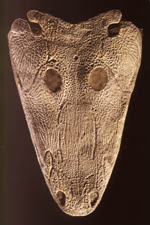 The beautiful thing about the Antarctic is that it is one of Earth’s last unexplored frontiers. New information about climate, geology, and paleontology is discovered regularly and today, the Journal of Vertebrate Paleontology announced the discovery of a fossilised amphibian which lived more than 245 million years ago in the Triassic of Antarctica. Its presence suggests that the climate at the time was mild enough to allow cold-blooded creatures to live near Pangea’s southern margin, at least seasonally.
The beautiful thing about the Antarctic is that it is one of Earth’s last unexplored frontiers. New information about climate, geology, and paleontology is discovered regularly and today, the Journal of Vertebrate Paleontology announced the discovery of a fossilised amphibian which lived more than 245 million years ago in the Triassic of Antarctica. Its presence suggests that the climate at the time was mild enough to allow cold-blooded creatures to live near Pangea’s southern margin, at least seasonally.
This news is of particular relevance to my work so I was very excited when I heard about it. For those of you that want to get technical, the amphibian, Parotosuchus was a large predatory temnospondyl that inhabiting lakes and rivers. For the layman: basically it was a 2m (6.5ft) long animal that superficially resembles a modern day crocodile, but was actually an amphibian.
Parotosuchus is differs from modern-day amphibians because of its form, large size and the fact that it was covered in a scaly skin. It was amphibious and so liked to live in the water and on land (but never far from the water) and swam in an eel-like fashion (see my posting from last month on the Robotic Salamander).
Previously, Parotosuchus remains have been discovered in Germany, Kazakhstan, Russia and South Africa, which up until now was its most southerly range. But in the Triassic, Africa and Antarctica were joined together in a supercontinent called Pangea so the find is not altogether a surprise. Parotosuchus was discovered in the Fremouw Formation of the Transantarctic Mountains, just six degrees short of the South Pole.
P.S. I stole the pic from the Tree of Life at http://tolweb.org/Temnospondyli





Comments